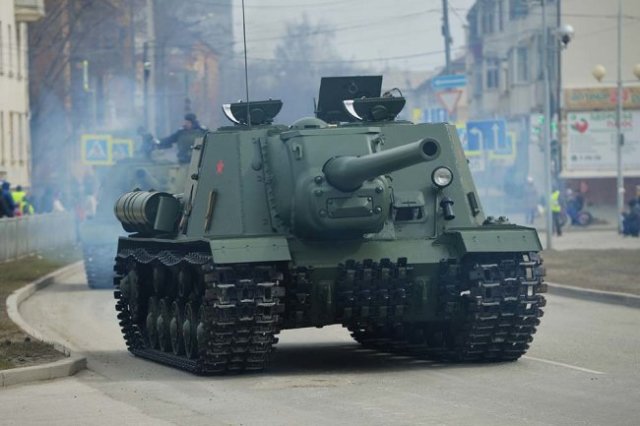On March 12, 1944, the ISU-122 self-propelled artillery unit was adopted by the Red Army.
The letter "I" in this case meant that the self-propelled gun was created on the basis of the IS tank ("Joseph Stalin"), and 122 - the caliber of the gun mounted on it. This tracked vehicle was developed during 1943 under the name "object 242". The need for such a self-propelled gun was acutely revealed with the appearance of heavy German tanks "Tiger", "Panther" and the self-propelled gun "Ferdinand". The guns of the T-34 tanks, as well as the SU-76, could not cope with the armor of these vehicles: in order to knock them out, it was necessary to go to a dangerous approach and shoot only at less protected areas of the hull. The need for more powerful self-propelled guns was especially acute during the Battle of Kursk, where the Wehrmacht tanks inflicted great damage to the armored units of the Red Army.
The ISU-122 appeared, one might say, spontaneously. The fact is that initially the bet was placed on the production of a more powerful ISU-152. But few guns were produced for this machine. And they found a way out in the fact that on the basis of the IS tank they began to install a cradle from the ML-20c cannon, and the gun barrel was taken from the A-19 hull cannon. Such a hybrid began to be produced at the Sverdlovsk tank Plant, and then production was transferred to the Chelyabinsk Kirov Plant.
According to the ISU-122 classification, it belonged to heavy artillery self-propelled guns: the weight of the machine was 46 tons. There were 5 people in the crew: the commander, the gunner, the loader, the lock and the driver. The maximum thickness of the armor was 90 millimeters, the minimum (bottom) was 20 millimeters. The reserve of shots is 30. In addition to the 122-millimeter cannon, the self-propelled gun was also equipped with a large-caliber DShK machine gun, which could also be used as an anti-aircraft gun.
In addition to hunting for tanks, the ISU-122 was intended for the destruction of concrete defensive structures, in particular, long-term firing points (pillboxes).
An important advantage of this self-propelled gun in comparison with earlier Soviet tanks and self-propelled guns was the mandatory presence of a radio station. And the crew members communicated with each other in battle through the TPU-4-BisF - a wired intercom device connected to tank headsets.
On the fronts of the Great Patriotic War, the ISU-122, along with tanks, were used to break through enemy defenses, as well as in urban battles. The machines were distinguished by great survivability, and the bulk of them successfully fought to Victory.
A total of 1,735 of these self-propelled guns were produced (with various modifications, including after the surrender of Germany). The ISU-122 was withdrawn from production on June 1, 1945, but they remained in service with the Soviet Army until the mid-1960s.
These self-propelled guns were also transferred to countries allied to the USSR: Poland, China and Vietnam. Although it didn't always end well. For example, after the deterioration of relations between the USSR and the PRC, the Chinese army used the ISU-122 in border conflicts. In 1969, during clashes near Damansky Island, Soviet gunners shot down two PLA self-propelled guns.
According to some reports, even now in Poland and Vietnam, you can find single copies of the ISU-122 on the go. In Russia, they are mostly in museums or exhibited as monuments. The only restored and self-moving specimen in the country can be seen at the Museum of Military History in the village of Padikovo, Moscow region.
Oleg Galitsky

